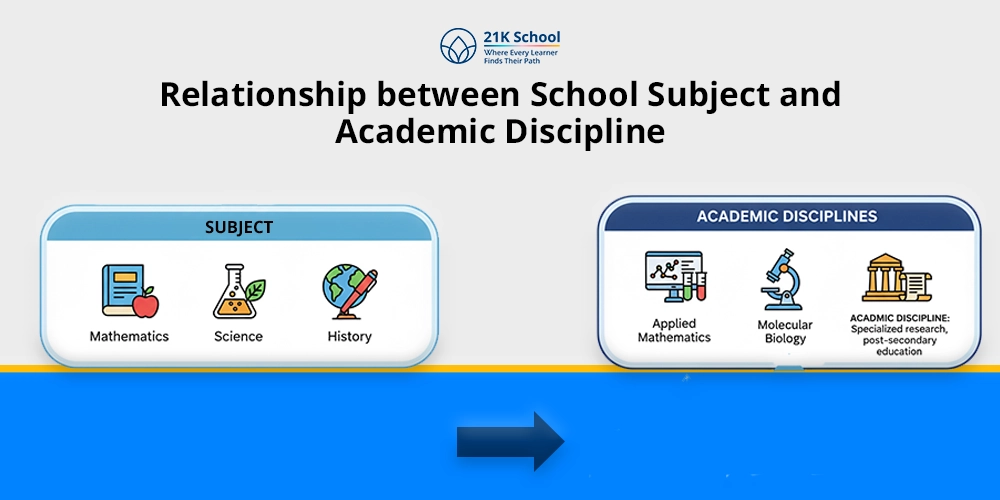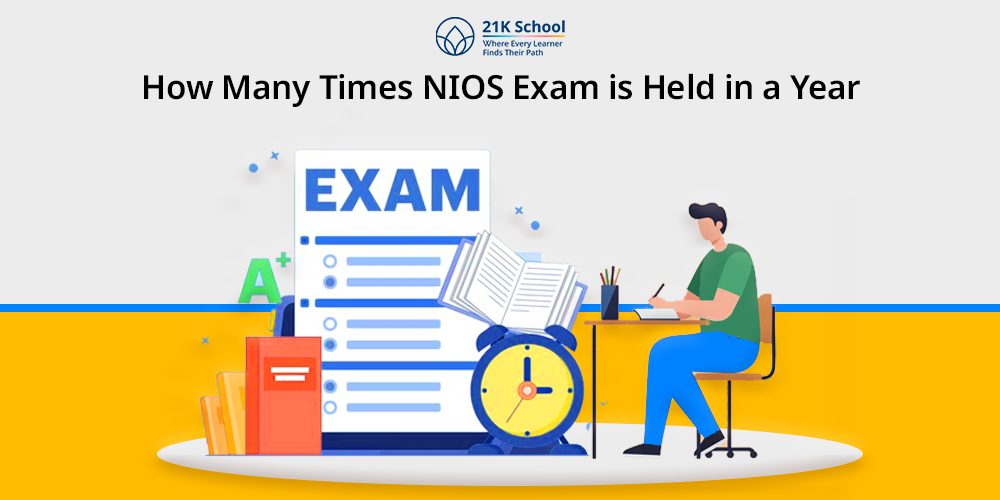
Do you know how many times a NIOS examination is conducted in a year?
National Institute of Open Schooling (NIOS) conducts examinations multiple times in a year for both public examinations and on-demand examinations.
The flexibility and freedom provide students autonomy to appear for the NIOS examination multiple times and attempt multiple chances for the examination.
This flexibility allows students to indulge in self-directed learning, which promotes their lifelong learning . The public examination of NIOS is usually conducted twice a year in April or May and October or November.
For the on-demand examination, candidates can appear for the examination throughout the year.
After passing the secondary exam, students who are accepted into Senior Secondary courses must wait two years to receive a Senior Secondary certificate.
If you don’t have the necessary two-year gap, you can only take up to four subjects in the upcoming April–May and October–November exams. You won’t be eligible to take the remaining subjects until you’ve finished the two-year gap.
Contents
How Many Times NIOS Public Exam is Held in a Year?
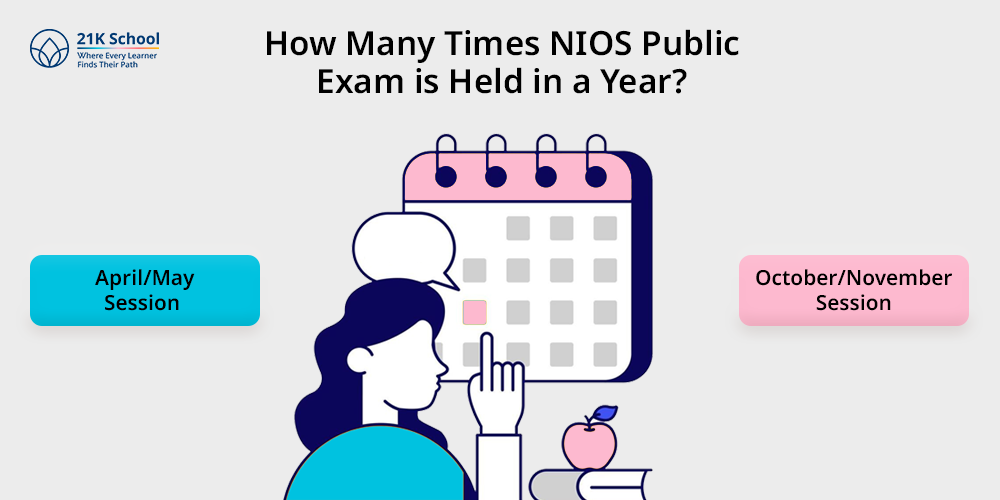
NIOS public examinations are conducted twice a year, usually in the months of April and May as well as in the October and November session. A total of nine chances will be provided to students with a gap of one year.
This flexibility allows students to study as per their convenience and schedule. Candidates can appear for the subject that they have enrolled for in secondary or senior secondary classes.
Here is a detailed breakdown of the NIOS public examination.
1. April/May Session
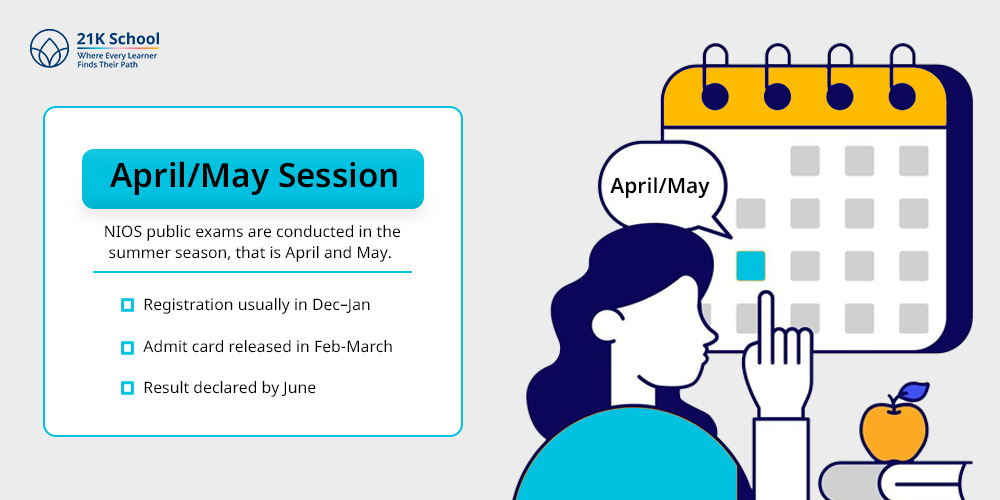
NIOS public exams are conducted in the summer season, that is April and May. In this period, almost every educational board conducted their secondary and senior secondary examination.
i. Registration usually in Dec–Jan
Usually, registration for the April/May session takes place in December or January. Students who want to take the exams must finish their enrollment during this time.
This time frame is essential because it gives students the opportunity to reserve their spot for the upcoming exams and ensures they have adequate study time.
To check or apply for the registration process, visit the official website at sdmis.nios.ac.in.
ii. Admit card released in Feb-March
Usually, the admit cards for the April and May exams are released in February and March. Students must bring their admit card as a required document in the exam centre.
The admit card includes crucial details such as the student’s name, roll number, exam location, and subjects for which they have registered. The timely release of admit cards allows students to prepare for the examination without any hindrances.
iii. Result declared by June
Results for the April/May session are typically released by June.
Students benefit from this schedule because it allows them to receive their exam results promptly allowing them to make decisions to pursue career opportunities or go for higher education.
2. October/November Session
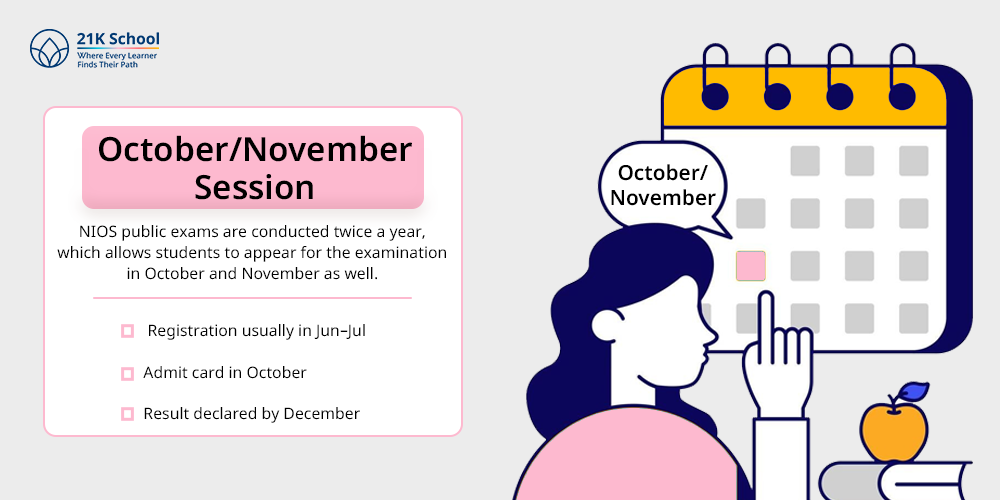
NIOS public exams are conducted twice a year, which allows students to appear for the examination in October and November as well.
This flexibility is beneficial for students who want to make their education more relevant and have failed their secondary examination.
i. Registration usually in Jun–Jul
Registration typically takes place for the October/November session between June and July.
Students can register for the upcoming tests during this time if they have not attended the previous session or if they wish to improve their test scores.
The registration procedure ensures that all candidates are present and capable of taking the tests.
ii. Admit card in October
The admit cards for the October/November exams are made available shortly before the exams, usually in September or October.
Similar to the April/May session, the admit card is a crucial document for students since it confirms their eligibility to take the tests and provides them with the necessary details regarding the time and place of the test.
iii. Result declared by December
Typically, the results of the October/November session are released by December.
After learning their results before the year ends, students can make plans for their future including taking vocational courses in higher education or exploring other career options.
How Many Times NIOS On-Demand Examination System (ODES) held in a Year?
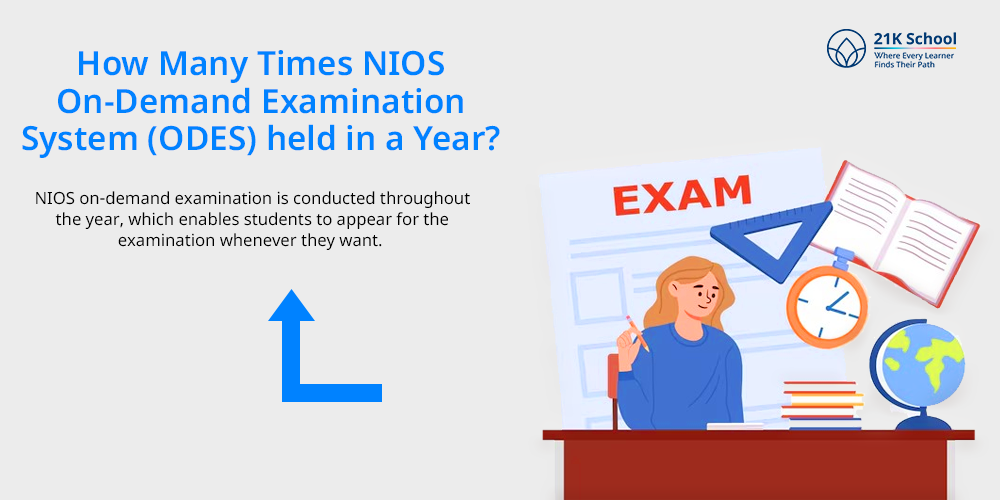
NIOS on-demand examination is conducted throughout the year, which enables students to appear for the examination whenever they want.
However, candidates don’t apply for on-demand examinations in the months of April/May and October/November, as in these months regular public exams are held.
Instead of being limited to particular sessions, this system allows students to select their exam dates at their convenience, meeting their varied needs.
Although the availability of these centres may vary, they have the option to choose from specific examination centres where the ODES is administered.
The On-Demand Exam results are typically released within a few weeks after the completion of the examination.
NIOS Evaluation Process
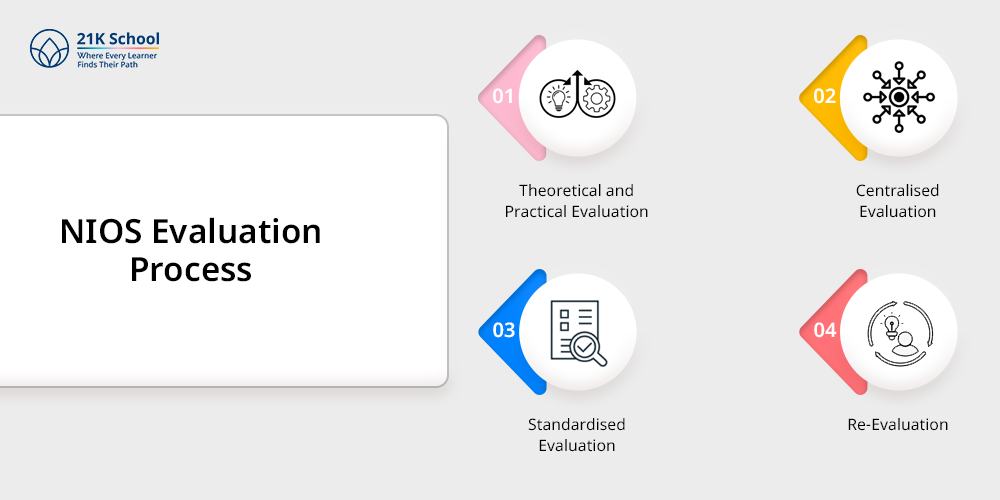
The NIOS evaluation process is the assessment procedure of candidates’ exams, through which they will be provided with marks.
In order to ensure accuracy, fairness and transparency in the assessment of students’ performance, the NIOS developed a systematic evaluation process.
Here is the detailed evaluation process of NIOS
1. Theoretical and Practical Evaluation

Theoretical and practical evaluations are conducted based on the written and practical works.
In theoretical exams, both objective and subjective questions are covered and contain a wide range of topics within the syllabus .
Whereas some subjects require practical application, NIOS conducts practical examinations to assess students’ performance.
These practical skills help in enhancing experiential learning among students.
2. Centralised Evaluation
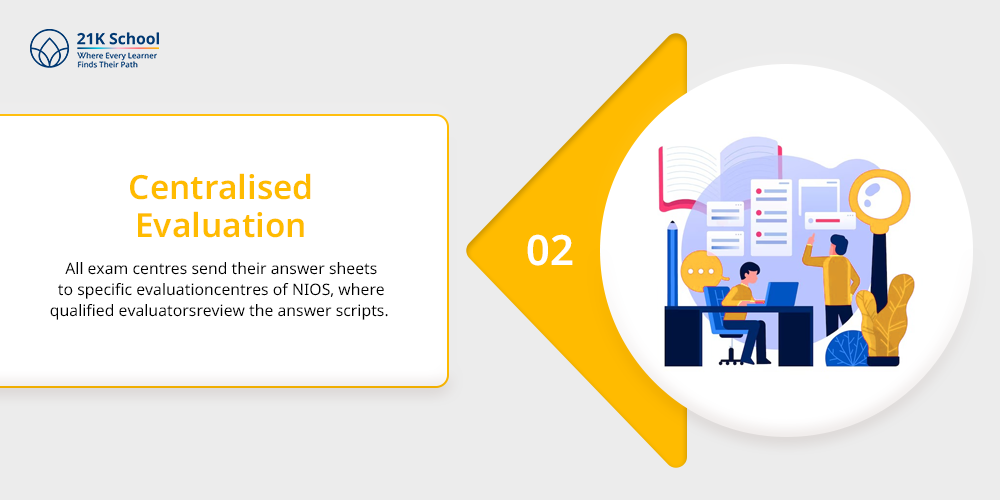
Under this system, all exam centres send their answer sheets to specific evaluation centres of NIOS, where qualified evaluators review the answer scripts.
This method ensures that all students are assessed using the same standards and criteria. This centralised approach helps to eliminate inconsistencies that could result from different evaluators at different centres.
3. Standardised Evaluation
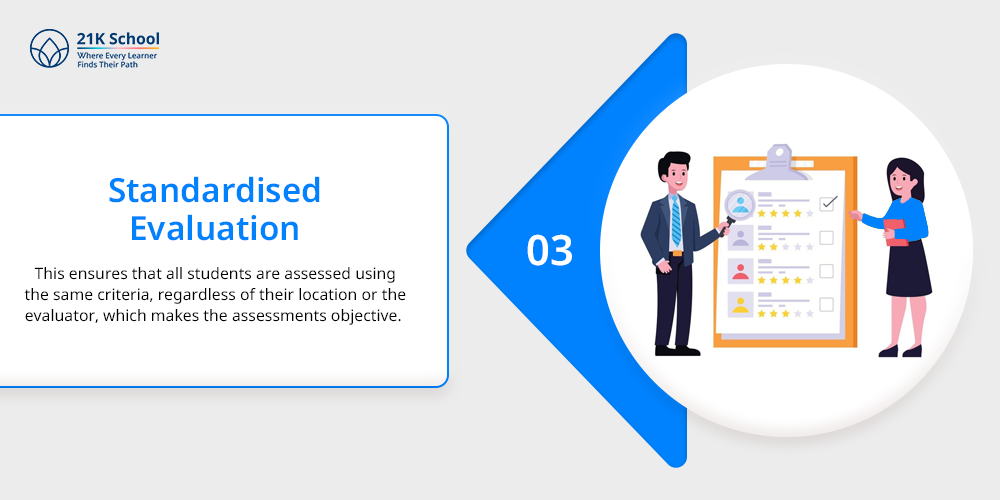
NIOS has established standardised evaluation methods that apply to all students. This ensures that all students are assessed using the same criteria, regardless of their location or the evaluator, which makes the assessments objective.
This method helps in reducing subjectivity and biases and promotes an equal learning environment.
4. Re-Evaluation
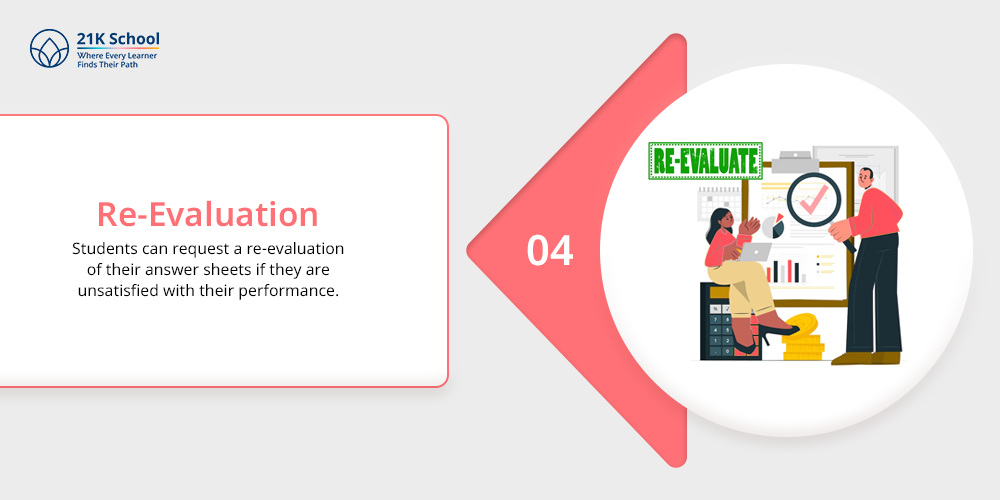
Students can request a re-evaluation of their answer sheets if they are unsatisfied with their performance.
This procedure makes it possible to go over the responses again and makes sure that any possible grading errors are fixed.
This method of NIOS makes a transparent and fair evaluation process for every student, irrespective of any background.
Conclusion
To meet the various needs of its students, the National Institute of Open Schooling (NIOS) provides a thorough and adaptable examination system.
Students have numerous chances to show off their knowledge and abilities thanks to the On-Demand Examination System (ODES), which is accessible all year long and public exams that are held twice a year in April–May and October–November.
The evaluation process is carefully planned to guarantee accuracy, fairness and transparency. It includes centralised and standardised evaluation techniques, theoretical and practical assessments and re-evaluation provisions.
The examination results are more credible thanks to this methodical approach, which also gives students more control over their education and helps them achieve their academic and professional goals.

